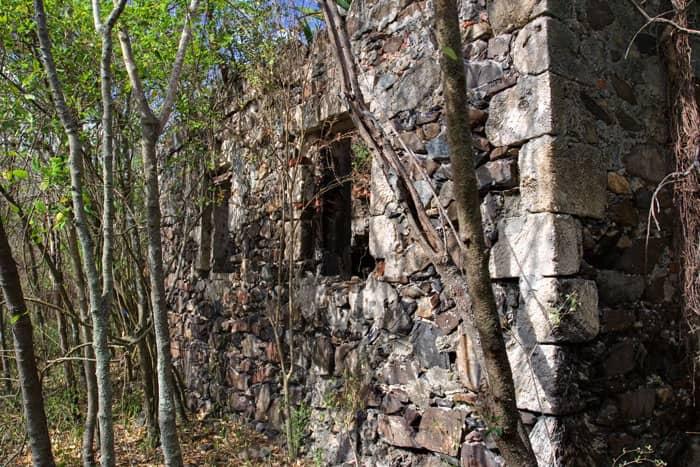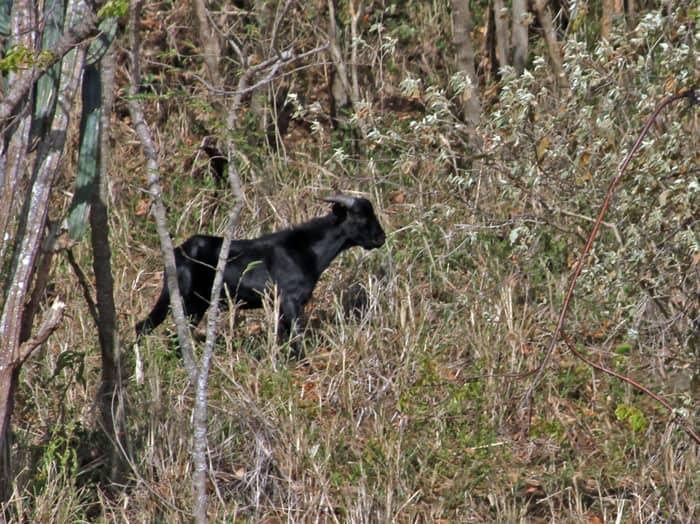Great Thatch Island lies just to the north of St. John. The approximately half-mile passage between Great Thatch and the St. John coast from the rocky cliffs of Mary Point and the steep tyre palm-covered hillsides between there and Leinster Bay form “the Narrows,” characterized by gusty winds and strong tidal currents.
I’ve snorkeled there and once camped out on the beach, but I always thought of the interior of the island to be impenetrable bush on cliff-like hillsides, which may be suitable for goats but not people. I was wrong.
Guided by a good friend and knowledgeable Virgin Islander, I took the opportunity to explore, for the first time, the island’s interior.

We began our adventure at the site of an unfinished building on the far eastern corner of the long beach on the southern coast. Rumor has it that this was to be built as a restaurant. Work started about 1997 but was plagued by misfortune.
Supposedly a dump truck full of gravel arriving by barge got stuck in the sand and remained stuck for quite some time. It was eventually removed, but I never heard how. The same sand that the truck got stuck in making the site look like a desirable beach location, but that was an anomaly, the natural state of that section of beach is gravel, to which it returned and is to this day.
We headed straight up the hill in the back of the building through a forest of mostly genip trees growing very close together. The vegetation was thick but passable, and we soon came to an old road bed running gradually up along the hillside.
We followed the road until my friend inexplicably decided that we should leave the road and continue straight up again towards the ridge, which we did, and which led us to the first of a series of ruins.

Smuggling and Great Thatch
I came across this little tidbit of historical information, which gives, among other things, a little picture of life on this island that I always thought to be either uninhabited or at least sparsely so.
“On being informed on November 24 (1856) that a boat belonging to an inhabitant of (Great) Thatch Island was trading without a license, the sub-treasurer of Tortola proceeded to seize it. He soon had to abandon the seizure, however, when he was assaulted and the crew of his boat badly beaten. Two days later, a force consisting of four constables was dispatched by the stipendiary magistrate to arrest the offenders. On landing they were obstructed by 40 or 50 people, and when the persevered and made their arrest were also severely beaten. On the following day, a larger force comprising 30 men, principally rural constables, 12 of whom were armed, was dispatched to quell the spirit of insubordination and to apprehend the offenders. Despite this show of force, it was only the assistance of the Wesleyan missionaries who were influential among the inhabitants, which enabled 16 arrests to be made without active opposition.” From “A History of the British Virgin islands” by Issac Dookhan
Great Thatch’s connection with smuggling may not be confined to the 19th century as rumors abound about bales of illicit things being found washed up on the shoreline there.
The name of the island itself suggests something nefarious. It is said that Thatch is a corruption of the name Teach and that the islands given the Thatch name, Thatch Cay in the US Virgins and Great and Little Thatch in the British, was named after the pirate Edward Teach, better known as Blackbeard.
Bottles
On our walk, we encountered many old bottles as well as other artifacts. It seems that this might help to date how recently people were still living on the island. Many of the bottles, it turns out, were manufactured by the Portobello bottle company in Edinburgh, Scotland, after 1907.

One More T’ing
All during our walk, we could hear the bleating of a goat, but we could never see him. Just as I was leaving, we spotted him…
